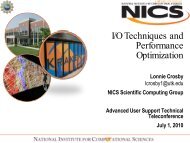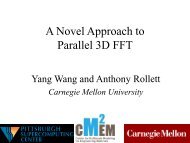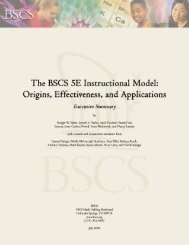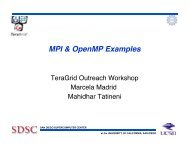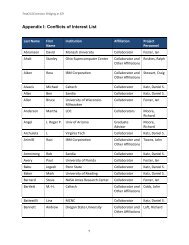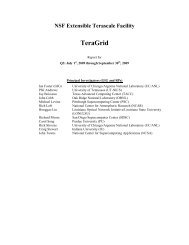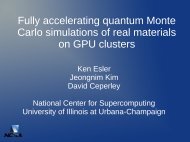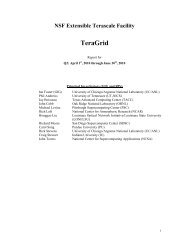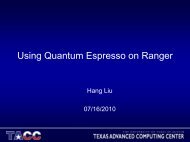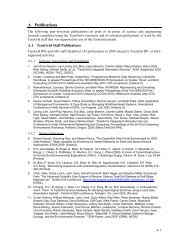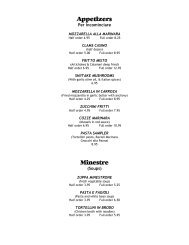TGQR 2010Q4 Report.pdf - Teragridforum.org
TGQR 2010Q4 Report.pdf - Teragridforum.org
TGQR 2010Q4 Report.pdf - Teragridforum.org
You also want an ePaper? Increase the reach of your titles
YUMPU automatically turns print PDFs into web optimized ePapers that Google loves.
supercomputers were a huge draw for little fingers which wanted to explore the easy-to-use<br />
screens.<br />
“It was great, because when the kids asked ‘What is a supercomputer’ we were able to show<br />
them pictures of the Data Center at Indiana University and the new Blue Waters facility at NCSA<br />
at the University of Illinois and also let them see LittleFe,” said IU-TeraGrid Outreach<br />
Coordinator Robert Ping. “LittleFe is like a baby supercomputer. It’s portable and is able to be<br />
used for training and doing demonstrations to show the computational power of a<br />
supercomputer,” he said.<br />
Educators loaded up their bags with NCSA coloring books and posters about supercomputing as<br />
well as publications like the TeraGrid EOT Highlights and Science Highlights. They were<br />
thrilled to have tangible items they could take back to their classrooms to start discussions about<br />
computer science, supercomputing and the many fields of study it touches.<br />
The EXPO was conceived in response to the Obama administration’s desire to encourage more<br />
interest in Science, Technology, Engineering, and Math (STEM) careers by exposing children<br />
and families to new technologies that are strengthening communities, building careers, and<br />
stimulating economic growth.<br />
The Pervasive Technology Institute’s Advanced Visualization Lab (AVL), part of the Data to<br />
Insight Center, created the stereoscopic video shown in the booth. It is centered on real-world<br />
applications of computational science and features current research that utilizes the TeraGrid.<br />
The stereoscopic video allowed kids and parents alike to don 3D glasses and get a glimmer of<br />
what it might be like to be a scientist working in the area of climate and weather.<br />
Animations of whirling wind turbines, swirling tornadoes and inching inch-worms combined with<br />
real-world research to show the study of climate isn’t just about the weather. It is useful in other<br />
areas of research and study like hydrology and agriculture as well. By using the NSF funded<br />
Linked Environments for Atmospheric Discovery (LEAD) project as the topic the public was also<br />
able to find out how their tax dollars are put to valuable use both as research tools and as ways to<br />
get kids interested in science and technology.<br />
Mike Boyles a volunteer from IU and manager of the AVL said, “It doesn’t really matter what the<br />
subject matter is of the video. The way the kids eyes lit up, their thoughtful questions and their<br />
expressions of “wow” and “whoa” were the real value we created by showing the 3D scientific<br />
movie.”<br />
This wasn’t the first time masses of people gathered on the National Mall to express their<br />
concerns and interests, but it was the first time that so many came to share their passion for<br />
science, engineering, and technology.<br />
“This expo is a chance for institutions like D2I and IU to show children that science and math<br />
aren’t the scary subjects they’re sometimes thought to be, and are actually a lot of fun,” said D2I<br />
Director Beth Plale. “Reaching out to young people and getting them intrigued in science and<br />
technology will be critical in the coming years in order for the U.S. to be competitive in the<br />
global scientific and economic landscape.”<br />
115



